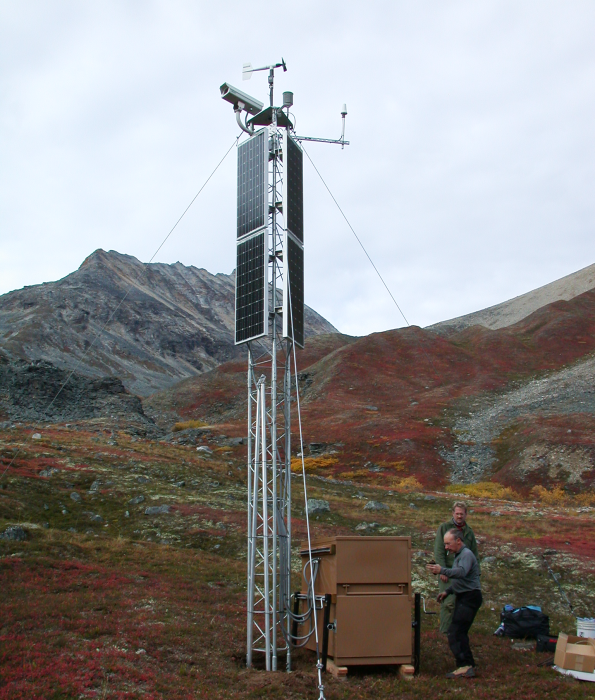
連邦航空局 (FAA) の主な目標の 1 つは、全国的に航空機事故を減らすことです。アラスカは地形が険しく、気象条件が急激に変動し、地域内の移動に航空機が利用されているため、一般航空事故の発生率が上昇するリスクがあります。アラスカの人口は米国の人口のわずか 0.2% ですが、パイロットの数は米国の他の地域と比べて 6 倍、航空機の数は 16 倍と推定されています1 アラスカの一般航空の年間飛行時間は 995,000 時間で、米国全体の約 3% を占めています。2001 年 1 月 1 日から 2006 年 1 月 10 日までの期間、米国では 6,990 件の一般航空事故が発生し、そのうち 454 件 (6.5%) がアラスカで発生しました2
州全体で、一般航空パイロットや小規模商業会社は、事故率の低減に役立つ気象カメラの使用を賞賛しています。これらのカメラは、VFR パイロットの飛行計画に不可欠な気象条件のほぼリアルタイムの画像を提供します。そのため、パイロットはアラスカのスティーブンス上院議員に、アラスカの山道に気象カメラを設置するための連邦資金の獲得に協力するよう依頼しました。上院議員は、アラスカの山道にカメラを追加設置するための FAA 資金を提供する法案の可決に協力し、複数の山道で飛行機の墓場が増え続けることがないようにしました。
気象カメラ (WCAMS) の目的は、パイロットの意思決定を支援することです。山道に設置された WCAM の画像を確認することで、パイロットは離陸前に VFR 飛行を試みるかどうかを決定でき、悪天候での飛行のリスクを軽減できます。カメラは飛行前の気象ブリーフィングを視覚的に提供し、峠の重要な場所の現場固有の情報をパイロットに提供します。
現在、レイク クラーク パスには 3 台のカメラが設置されています。建設スケジュールでは、FAA はレイク クラーク パスへの追加設置と、メリル パス、レイニー パス、および/またはプタルミガン パスへの設置を提案しています。通常、ルート上の気象状況を評価できるように、1 か所につき 2 台から 4 台のカメラが設置されます。画像は 10 分ごとに撮影され、FAA の Web サイトで公開されます。各場所の Web ページには、断面マップ、地形図、および視野方向によって名前が付けられた複数のカメラ画像 (北、南、東、西など) が含まれています。ページには、現在の状況を示す画像と対照的な「晴天」画像も含まれています。
FAA は現在、2005 年秋に設置された Iridium 衛星機器のフィールド テストを行っています。テスト インストールでは、CC640 デジタル カメラ、Campbell Scientific データ収集機器のパフォーマンス、および Iridium 通信リンクの可用性を検証しています。テスト構成では、リモート パス サイトに 2.4K モデムがあり、CR1000 に保存されている画像を取得するために Loggernet の LNcmd.exe を使用してテスト プラットフォームにリンクされた追加のモデムがあります。10 分ごとに、Loggernet タスクがリモート機器に接続し、最新の画像、気象データ、および機器データを取得します。現在、このデータは FAA テスト サーバーにあります。FAA は、2006 年春から VSAT 通信リンクのフィールド テストも開始する予定です。
FAA は、CC640、CR1000、およびその他の機器の低温性能に満足しています。ヒーターの必要性が減り、機器の消費電力も低くなったため、追加のバッテリー、ソーラー パネル、風力発電機の必要性が減りました。このシステムは、充電レギュレータを介して 200 Amp-Hr ガラス マット バッテリーに接続された 4 つの 85 ワット ソーラー パネルによって稼働します。電力予算の大部分は Iridium 衛星送信機に割り当てられるため、消費電力の少ない通信形式を使用するサイトでは、より控えめな電源装置を装備できる可能性があります。
さらに電力を節約するために、CR1000 には、民間薄明を計算するアルゴリズムがプログラムされています。民間薄明とは、日の出と日の入りの前の、太陽の中心が地平線から 6 度下にある時間帯のことです。民間薄明の照明は、天候が良好な場合、地上の物体をはっきりと見分けるのに十分です。データロガーは、このアルゴリズムの出力を使用して、夜間に必要のない機器の電源をオフにします。
機器は、太陽の視界が限られ、極寒の厳しい山道に設置されるため、Campbell Scientificの機器が、遠隔地の自己完結型カメラ設置の標準となる可能性が高い。1
https://www.census.gov/quickfacts/qfd/states/0200.html 2 http://www.ntsb.gov/Pages/default.aspx